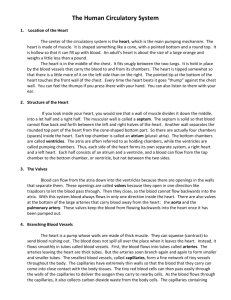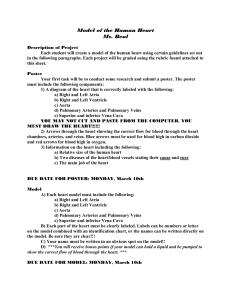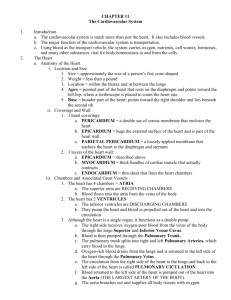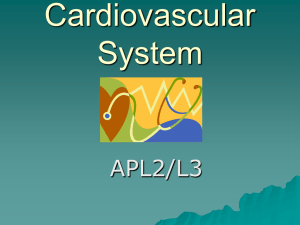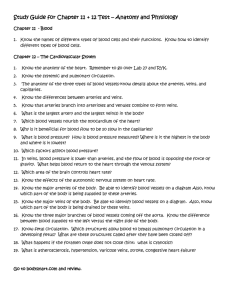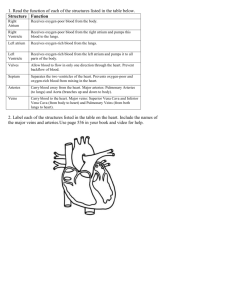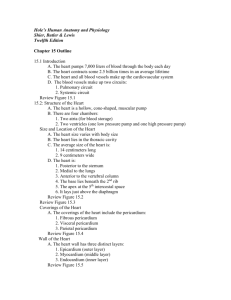File
advertisement
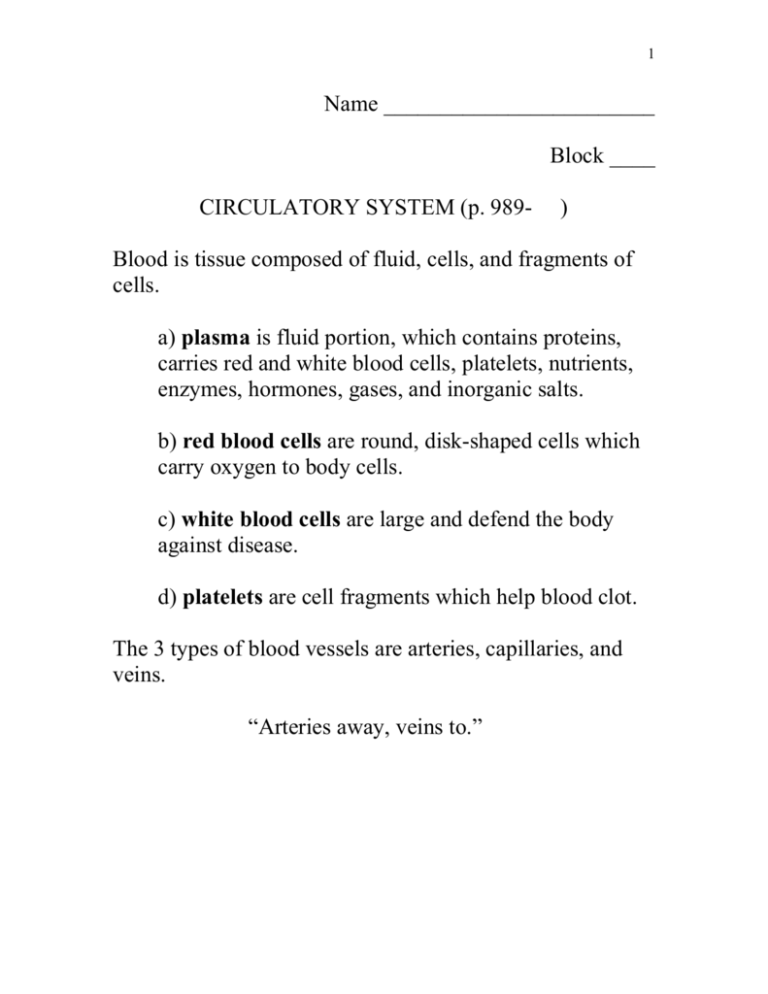
1 Name ________________________ Block ____ CIRCULATORY SYSTEM (p. 989- ) Blood is tissue composed of fluid, cells, and fragments of cells. a) plasma is fluid portion, which contains proteins, carries red and white blood cells, platelets, nutrients, enzymes, hormones, gases, and inorganic salts. b) red blood cells are round, disk-shaped cells which carry oxygen to body cells. c) white blood cells are large and defend the body against disease. d) platelets are cell fragments which help blood clot. The 3 types of blood vessels are arteries, capillaries, and veins. “Arteries away, veins to.” 2 I. Arteries are large, thick-walled, muscular, elastic vessels that carry oxygenated blood (looks bright red) away from the heart. -blood is under great pressure -elastic walls of arteries expand and shrink, pushing on the blood so it can continually flow. -after arteries branch from heart, they eventually divide into the smallest blood vessels, called capillaries. II. Capillaries are microscopic blood vessels with walls only 1 cell thick. *This allows nutrients and gases to diffuse between the blood and tissues. -As blood leaves the tissues, capillaries join to eventually merge into veins. III. Veins are large blood vessels that carry blood from the tissues back to the heart. (Blood almost always looks darker b/c less oxygen) -because blood in veins isn’t under as much pressure as the arteries, veins have valves that prevent blood from flowing backward. 3 HEART -The heart is a large organ, about 12 cm by 8 cm, or the size of your fist. -It is made of cardiac muscle cells rich in mitochondria (for constant energy) -All mammalian hearts have 4 chambers. -2 upper chambers are atria and 2 lower chambers are ventricles BLOOD PATHWAY a) Right atrium receives oxygen-poor blood from head and body through 2 large veins called venae cavae. b) At same time, left atrium receives oxygen-rich blood from lungs through 4 pulmonary veins (only veins that carry blood rich in oxygen—look redish). 4 c) After atria have filled with blood, the 2 atria contract, pushing blood into 2 ventricles. d) When right ventricle contracts, it pushes oxygen-poor blood from right ventricle (against gravity) out of the heart and toward the lungs through the pulmonary arteries (only arteries that carry blood poor in oxygen—look bluish) e) At same time, left ventricle pushes oxygen-rich blood out of the heart through aorta into the arteries. *Aorta is largest blood vessel in body. **Before blood goes to rest of the body, it has to enter the lungs to pick up oxygen. 5 TRACE OF BLOOD THROUGH HEART LEFT ATRIUM LEFT VENTRICLE SUPERIOR VENA CAVA RIGHT ATRIUM RIGHT VENTRICLE INFERIOR VENA CAVA PULMONARY ARTERY PULMONARY VEIN LEFT LUNG RIGHT LUNG *Between atria and ventricles, are 1-way valves that keep blood from flowing back into the atria. 6 HEARTBEAT REGULATION -Each time the heart beats, surge of blood flows from left ventricle into aorta and then into arteries, called a pulse. -Heart rate is set by pacemaker, a group of cells at top of right atrium. -pacemaker generates electrical impulse that spreads over both atria and ventricles, causing them to contract -Medulla oblongata in brain regulates rate of pacemaker. BLOOD PRESSURE -blood pressure is force that blood exerts on vessels of the body. Pressure rises and falls as the heart contracts and then relaxes. -Blood pressure rises sharply when ventricles contract. High pressure is called systolic pressure. -Blood pressure then drops as ventricles relax. The lower pressure is just before ventricles contract again and is called diastolic pressure. 120 mm Hg –systolic pressure 80 mm Hg –diastolic pressure
